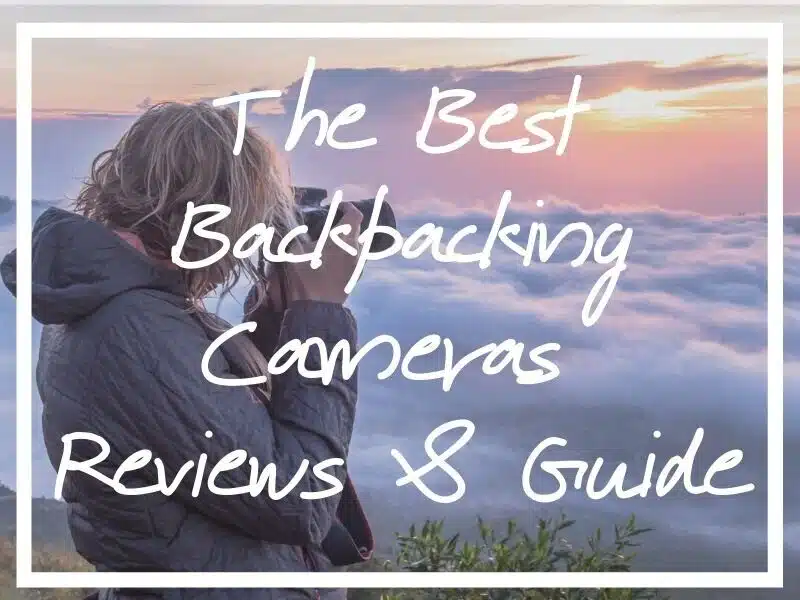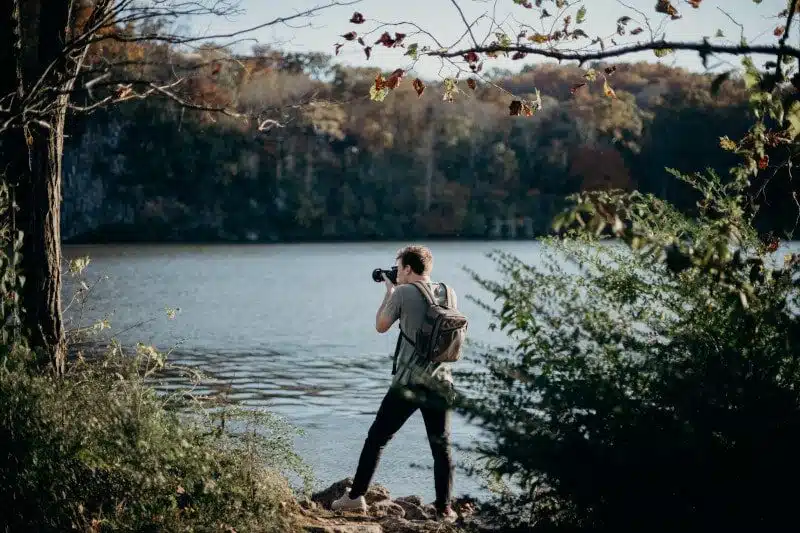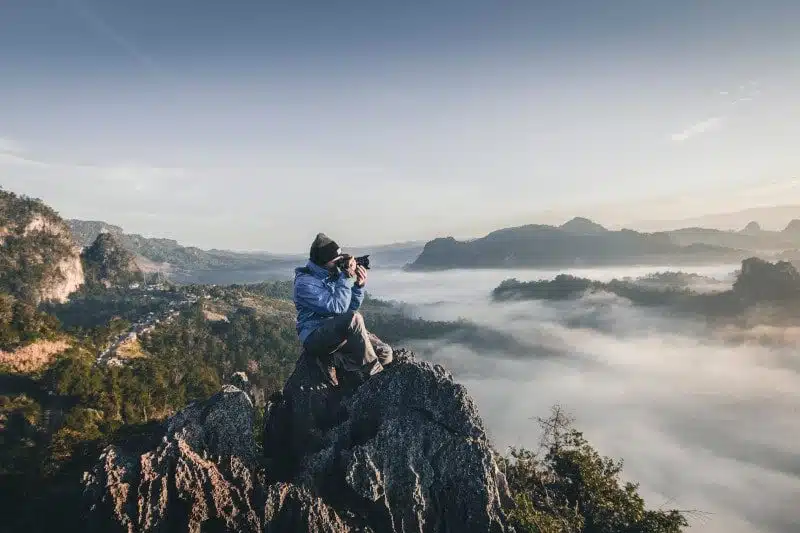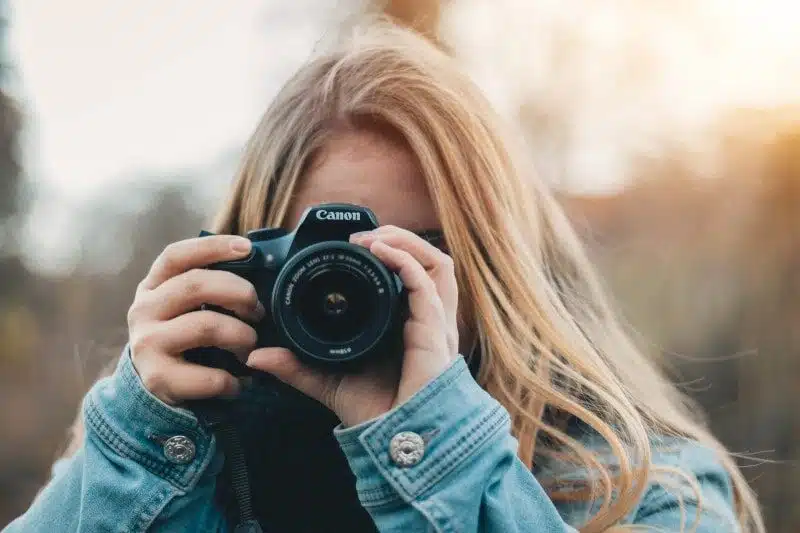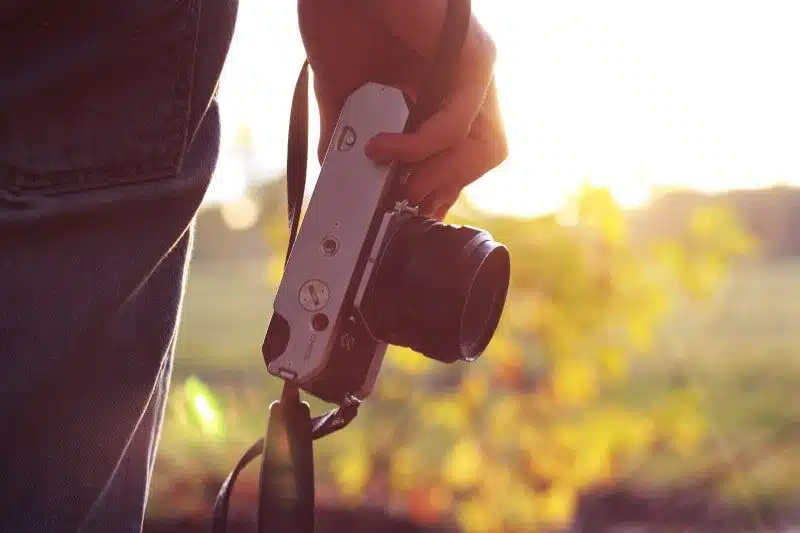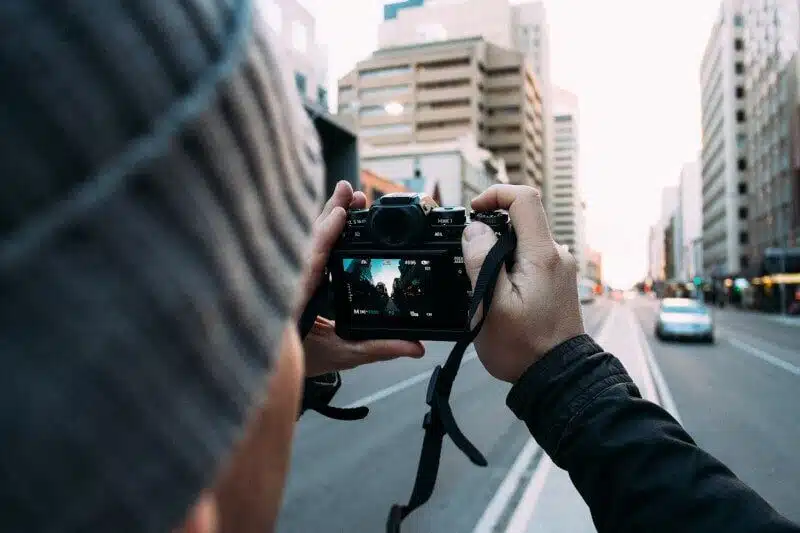I hope this guide to the best backpacking cameras comes in handy!
Photos immortalise your travels.
Seriously, when your adventure comes to an end and all you have left are memories, the photos you took become a priceless look back at the amazing things you did.
Which is why it’s so important to have the best backpacking camera possible on your trip!
However, there are so many possibilities when hunting for the best camera for hiking and backpacking that it can be difficult to choose one…
I wanted to help!
I’ve done some digging and found 12 of the best cameras for backpackers on the market. Hopefully, the coming buying guide will help you pick the best camera for backpacking possible.
Keep reading to discover all about 12 of the best backpacking cameras you could take on your travels.
[Last updated: January 2021]
Heads up, this post contains affiliate links!
The Best Backpacking Cameras – Summary Table
Type: Compact
Megapixel: 20.3
Weight: 300g
Price:
Type: Action
Megapixels: 12
Weight: 250g
Price:
Type: Mirrorless
Megapixels: 16.1
Weight: 411g
Price:
Type: Compact
Megapixel: 20.2
Weight: 243g
Price:
Type: Action
Megapixels: 20
Weight: 454g
Price:
Type: Mirrorless
Megapixels: 24.3
Weight: 346g
Price:
Type: Compact
Megapixels: 12.8
Weight: 243g
Price:
Type: Bridge
Megapixels: 21.1
Weight: 831g
Price:
Type: DSLR
Megapixels: 18
Weight: 400g
Price:
Type: Budget
Megapixels: 18.2
Weight: 121g
Price:
Type: Bridge
Megapixel: 20.1
Weight: 832g
Price:
Type: DSLR
Megapixels: 24.2
Weight: 465g
Price:
Important Considerations When Choosing the Best Backpacking Camera
It’s important to take the following things into account when choosing your travel camera:
1. Your Budget for a Good Camera for Backpacking
The price range for cameras is huge.
You can find a brand new digital camera for as little as £40 (Around $50). But for higher quality kit the price quickly rises, and can easily stretch into the thousands.
Like all things, how much you are willing to spend is totally up to you.
Generally speaking you get what you pay for with cameras though. Paying that bit extra can make a big difference if you’re after top quality snaps.
In the cameras listed below I’ve tried to cover cameras for most budgets.
However, all of them fall above the hundreds of pounds/dollars mark. Any less and you seem to sacrifice image quality and fitness for purpose.
2. The Amount You Can/Want to Carry
Higher end cameras tend to have all sorts of additional parts.
There are lenses, tripods, extra batteries, memory cards, cases and so on.
And all of it has to be carried around with you if you’re backpacking!
If you don’t want to (or simply can’t) lug around a lot of stuff, then consider simpler types of camera.
3. Camera Weight & Portability
Similarly, some cameras (think DSLRs…) can be bulky.
And bulk equals extra weight to carry.
The bigger cameras tend to offer the higher quality photos, but will be inappropriate for anyone trying to save on space and weight.
4. The Effort to Learn
Turns out a lot goes into the whole photography thing!
How much effort are you willing to put into learning?
The fancier models require an understanding of things like aperture, aspect ratio, depth of field, exposure…and so on.
Without this, even with the fanciest, most expensive camera and lens in the world, your photos will be average at best.
So, if you’d rather just pick up a camera and start shooting straight away, go for a simpler option.
5. Your Travel Style
Finally, think about the manner in which you’re going to be travelling.
For instance, if you’re a fast paced traveller then a quick point and shoot camera might be perfect.
If you’re slower and steadier, a heavier option with a greater spec could suit you better.
Equally, what are you going to be doing?
Hiking? Spending time outdoors? In water? In nature? Exploring cities? Moving around a lot?
All of these factors will affect the type of camera that’ll be best for your trip.
Backpacking cameras take many forms. It’s important to think about your needs and proceed accordingly.
The Best Camera to Take Backpacking: Types, Pros, & Cons
Now let’s turn to the different types of camera available and their relative pros and cons.
Compact/Point and Shoot
Compact cameras (otherwise known as point-and-shoot cameras) are generally a step up in quality from smartphones.
Used and loved for their small, simple, user friendly nature, just point the camera and press the button to get great quality pics.
Specs can be pretty limited, but tend to offer more manual control over snaps than smartphones do, as well as optical zooms.
Compacts would be a good choice for travellers looking for high quality photos with minimal effort.
Compact Camera Pros:
- Exceptionally easy to use
- Very little learning required
- Portable and lightweight
- More features and manual control versus smartphones
- Image quality generally better than smartphones
Compact Camera Cons:
- Image quality can still be an issue (especially in low light)
- Limited aperture and zoom
- More complex photography is generally not possible
Bridge Cameras
A bridge camera is essentially a cross between a compact camera and a DSLR (see below).
As in, it bridges the gap between them…and allows you to cross it in the process…yep.
Anyway, in practice this means they offer a similar style to DSLRs (with a viewfinder, long range zoom lens and manual control) but are easier to use and usually without interchangeable lenses.
Bridge cameras were originally made to provide a budding photographer a high quality camera at a price tag cheaper than actual DSLRs.
This means it could be ideal for someone hoping to take great photos without the steep learning curve or the expense of fancier options!
Bridge Camera Pros:
- High quality photos
- Viewfinder, long range zoom and manual controls
- Smaller than a DSLR
- Ideal stepping stone to complex photography
Bridge Camera Cons:
- No interchangeable lenses
- Manual controls are limited versus fancier camera options
- Less compact than a compact
- More expensive than a compact
Mirrorless Cameras
From what I gather, mirrorless cameras have been something of a revolution in the world of photography.
Essentially, in DSLRs there’s a mechanical mirror that switches the scene between the viewfinder and image sensor.
But in mirrorless cameras there isn’t.
Meaning they’re smaller than DSLRs while offering the same features and functionality.
So, that means full manual controls, interchangeable lenses and exceptional quality photographs.
They don’t come cheap, but if you are a serious photographer (or plan to become one) these come highly recommended by photographers all over the web.
Mirrorless Camera Pros:
- Exceptional image quality
- Smaller than a DSLR
- Full manual controls and interchangeable lenses
Mirrorless Camera Cons:
- Expensive
- Takes time to learn and master
DSLR Camera
DSLRs (digital single lens reflex) cameras have long been the quintessential camera of choice for photographers.
With full manual controls and interchangeable lenses they can create photos of the highest quality.
Again though, they can get eye wateringly expensive.
However, there are affordable ones around these days.
And you get what you pay for: the image quality, when used well, is arguably worth the money for serious photographers.
DSLR pros:
- Exceptional image quality
- Full manual controls and interchangeable lenses
DSLR cons:
- Expensive
- Large and heavy
- Takes time to learn and master
You might also like:
Time to move onto the main event. Below you’ll find my picks of the best backpacking camera for all of your travel photography needs!
The Best Camera for Hiking and Backpacking
Finally, let’s crack on with my buying guide to the best camera for backpacking out there.
The Best Compact Camera for Backpacking
1. Panasonic Lumix ZS50 (TZ70 outside US)
Summary:
- Type: Compact
- Megapixel: 12.8
- Weight: 243g
Panasonic Lumix ZS50/TS70 Review
Compact cameras don’t come much better than Panasonic’s ZS/TZ series.
The ZS50 (or TZ70), depending where you are in the world, is no exception.
With a 12.8MP high sensitivity sensor, it also comes with an electronic viewfinder, which makes snapping the perfect pic that bit easier in certain lighting.
Not to mention a huge 30x zoom.
Oh, and it connects to Wifi too, enabling easy uploads of your snaps!
In terms of shooting, simply leave it in auto and you’re good to go. Or, for control over aperture and shutter speed why not shoot raw files instead (great if you’re looking to edit photos).
It’s slightly larger than other compacts, weighing in at 243g.
But it’s by no means big and will easily fit in your pocket when you’re out and about!
Pros:
- 30x zoom
- Electronic viewfinder
- Wifi
- 1080p movie capabilities
- Good value for money
Cons:
- No touchscreen
- Other Panasonic’s pack larger sensors
–> Click here to learn more about the Lumix online.
2. Canon Powershot SX730 HS
Summary:
- Type: Compact
- Megapixel: 20.3
- Weight: 300g
Canon Powershot SX730 Review
The Canon Powershot SX730 really does sound ideal for travel.
This 20.3MP camera is great for newbies and those with more experience alike as you can switch easily between full manual, semi-auto and full-auto mode.
Undoubtedly one of the Powershot’s greatest features though is its ginormous 40x optical zoom.
This would be a great bet if focal length flexibility is something you’re after.
Another cool feature is a tilting screen that’ll take the guesswork out of selfies! Just flip it up, aim the camera in your direction and see exactly what’s happening.
If you’re travelling alone then this could come in especially handy.
Unfortunately there’s no touchscreen here, but the zoom, tilting screen and general ease of use make this a very appealing backpacking camera.
Pros:
- 20.3MP
- 40x optical zoom
- 1080p movie capabilities
- Tilting screen
- Good value for money
Cons:
- No touchscreen
- No Wifi
- No viewfinder
–> Click here to learn more about the Powershot online.
3. Sony Cyber-shot RX100
Summary:
- Type: Compact
- Megapixel: 20.2
- Weight: 243g
Sony Cyber-shot RX100 Review
The Sony RX100 has actually been replaced now with a series of cameras (we’re now at the RX-100 VI, apparently!).
However, the original RX100 is still being manufactured and comes with stellar recommendations online- especially if you’re on a budget.
This camera is another great compact option for travellers looking to take rapid fire high quality photos with minimum effort.
It boasts a bunch of awesome features including full manual control, RAW format shooting capabilities and a top end 20.2MP sensor.
By all accounts this is a fantastic camera to take backpacking, taking awesome photos even in low light.
Later versions of the RX100 in the series also boast a handy touchscreen.
Pros:
- High quality sensor
- Highly recommended
- Full manual control
- Full HD video recording
- Good value for money in terms of sensor size
Cons:
- Higher price tag
- Original RX100 lacks special features of newer models in the series
–> Click here to learn more about the Cyber-Shot online.
The best camera for backpacking takes different forms, depending on your need. Keep reading to learn the best camera for hiking and other action sports.
The Best Bridge Camera for Backpacking
4. Sony RX10
Summary:
- Type: Bridge
- Megapixel: 20.1
- Weight: 832g
Sony RX10 Review
This ‘superzoom compact’ bridge camera is hailed as a game changer online.
There are a bunch of newer models but I decided to include the original as it is far cheaper than it’s younger siblings!
And the Sony RX10 still boasts some impressive specifications, including its renowned 20.1MP 1inch sensor.
It has a constant f/2.8 aperture which is discussed as a major plus point, as is said to shoot outstanding quality images.
There’s also a top notch tilting screen (more selfie love) and full HD video capabilities.
The only downside of the original is a lack of touchscreen.
Otherwise, if you’re after a DSLR style camera that’s simple to use, the Sony RX10 seems a great choice.
Pros:
- Awesome image quality
- 20.1MP 1inch sensor
- Constant f/2.8 aperture
- Tilting screen
- Relatively cheap
Cons:
- Lacks features of newer models
- No touchscreen
- No 4K videoSony RX10
–> Click here to learn more about the RX10 online.
5. Panasonic FZ1000
Summary:
- Type: Bridge
- Megapixels: 20.1
- Weight: 831g
Panasonic FZ1000 Review
Another prime option for a new superzoom compact camera is the Panasonic FZ1000.
Also boasting a 20.1MP 1inch sensor, the image quality of the Panasonic is comparable to the Sony RX10, but at an even lower price point.
This camera is real bang for your buck, coming with some nice specifications (such as 4k UHD video and f/2.8-4 aperture).
Another nice feature is its Wifi and NFC capabilities, where NFC enables contactless communication with other NFC devices.
It’s true that the Panasonic FZ1000 lacks a touch screen, but all told is hard to critique.
Pros:
- Great value for money
- 20.1MP 1inch sensor
- Wifi and NFC enabled
- 4K UHD video
Cons:
- No touchscreen
- Bulky in size
–> Click here to learn more about the FZ1000 online.
The Best Mirrorless Camera for Backpacking
6. Sony Alpha A6000 (The Best Camera for Outdoor Photography)
Summary:
- Type: Mirrorless
- Megapixels: 24.3
- Weight: 346g
Sony Alpha A6000 Review
With a price that puts some bridge cameras to shame, the mirrorless Sony Alpha A6000 is perfect for photographers on a budget.
And you don’t sacrifice much in terms of image quality either, with its 24.3MP APS-C image sensor rising to the occasion.
Check out its weight too: 346g (12.2oz) makes it amazingly portable for backpacking.
Combined with 1080p HD video, built in Wifi and NFC, this camera is perfect for backpackers who want to take some serious photos on their trip.
However, its lack of weather resistance could be some cause for concern on your travels. All told and from all accounts though, you can’t go too far wrong with the Sony Alpha A6000.
Pros:
- Tremendous value for money
- 24.3MP APS-C sensor
- Lightweight and portable
- High quality images at a great price
Cons:
- No 4K video
- Not weather resistant
–> Click here to learn more about the Alpha A6000 online.
7. Olympus OM-D E-M10 Mark III
Summary:
- Type: Mirrorless
- Megapixels: 16.1
- Weight: 411g
Olympus OM-D E-M10 Mark III Review
The Olympus OM-D E-M10 Mark III is another fantastic mirrorless choice at an exceptional price point.
Designed originally by Olympus as a cheaper alternative to some of their pricier cameras, the E-MD10 Mark III packs the same high quality image and video into a smaller price tag.
Of particular note with this camera is its supreme video capabilities. With 4K video this is a great bet for anyone planning on shooting videos while travelling.
It’s also got a reputation for being powerful and responsive.
At 16MP though the image quality isn’t as great as some others and it’s slightly heavier than the Sony Alpha A6000.
All told though this camera is another that comes highly recommended.
Top tip:
If you are looking to save some money though, try the EM-10 Mark II instead.
From what I gather, its specs match that of the Mark III in most ways apart from the video capabilities, but it comes in a couple of hundred cheaper!
Pros:
- 4K video
- Great image stabilisation
- High end user experience
Cons:
- Only 16MP
- Relatively expensive for 16MP
–> Click here to learn more about the Olympus Mark III online.
Having covered the best bridge and mirrorless cameras, let’s turn to the best backpacking DSLR. From there, I’ll turn to the best budget camera for backpacking and the best underwater camera for scuba diving and other water activities.
The Best Backpacking DSLR Camera
8. Nikon D5600
Summary:
Type: DSLR
Megapixels: 24.2
Weight: 465g
Nikon D5600 Review
The main issue with DSLRs for travellers is often their size- where weight and general bulk can make portability a problem.
I’ve included The Nikon D5600 in this list as it goes some way to countering this issue. Now, it’s still bulky, but not compared to some!
The key plus point to this DSLR is its image quality though, with a 24MP sensor creating fantastic photos. And the 3.2in vari-angle touchscreen to view them on is another bonus!
Likewise, this is a cheap DSLR and you get a decent bang for your buck here too. The Wifi, NFC and Bluetooth capabilities putting the icing on the cake.
Pros:
- High quality image quality
- 24MP sensor
- Touchscreen
- Wifi, NFC and Bluetooth
- 1080p video capabilities
- Good value for money
Cons:
- Bulky compared to mirrorless counterparts
- Autofocus quite slow
–> Click here to learn more about the D5600 online.
9. Canon Rebel SL1 (Rugged DSLR)
Summary:
- Type: DSLR
- Megapixels: 18
- Weight: 400g
Canon Rebel SL1 Review
The Canon Rebel SL1 is another lightweight DSLR at a great price.
In fact, its design has made its bulk comparable to mirrorless cameras of similar specs. That said, it remains larger than the mirrorless examples in this list.
Nonetheless, this DSLR gives popular mirrorless cameras a run for their money.
With an 18MP APS-C sensor it boasts impressive image quality and offers users the same power as its larger Rebel series counterparts.
The touchscreen at the back is another handy feature that’s fixed (as opposed to tilting) in order to save weight.
All in all the Canon Rebel SL1 is a fantastic, pint-sized yet powerful DSLR that provides amazing value for money.
Pros:
- Lightweight
- 1080 video capabilities
- Small in size for a DSLR
- Good value for money
- Rugged DSLR
Cons:
- Touchscreen doesn’t tilt (but saves weight)
- 18MP is low compared to other models
- Lacking in some technical areas
–> Click here to learn more about the Rebel SL1 online.
Moving onto the best cameras for adventure, including the best underwater camera for scuba diving and the best camera for hiking trips!
The Best Cameras for Backpacking Adventures
The cameras above cover the main forms of camera out there.
However, there is another type of camera that gets talked about online: action cameras.
Simply put, these are cameras that are perfect for adventure sports and activities.
As this piece is about the best cameras for backpacking, and everyone who backpacks tends to enjoy an adventure, I thought it made sense to list a couple of the best action cameras out there too.
Check out my two picks for the best camera for adventure:
Best Underwater Camera for Scuba diving, Snorkelling, Swimming…
10. GoPro Hero 9
Summary:
Type: Action
Megapixels: 20
Weight: 454g
GoPro Hero 9 Review
Let’s start with a suggestion for the best underwater camera- not to mention the best action camera, period:
The GoPro Hero 9’s the real deal.
Now, all GoPros are great for taking on an adventure, whether you’re hiking, climbing, camping, kayaking, trail running, and so on…
With the right accessories, you can strap them to your body, attach them to a helmet, fix them to a pole, or place them on basically anything. This provides an epic vantage point from which to film yourself on adventurous activities.
As a fully waterproof camera (down to 33ft), it also pips the post as the best camera for snorkelling and other underwater experiences on this list.
The Hero 9 isn’t cheap, but it’s arguably worth the expense.
This tiny GoPro (9.1” x 5.4” x 3.3”) boasts some insane specifications.
It has a 23.6MP sensor that snaps 20MP photos, has AI capabilities (SuperPhoto), shoots 5k video, and has a front display (AKA it’s great for selfies) and a rear touch screen.
As I mentioned before, it’s water-resistant to 33ft (10m) and can even function as a webcam with live-streaming capabilities. there’s a touchscreen and ‘Touch Zoom’ functionality with wifi to boot.
With all these features and a miniscule size and weight, this is arguably the best camera for adventure photography available.
Pros:
- Water resistant to 33ft (10m)
- Touchscreen
- Wifi
- Touch zoom
- 12MP images
- 4K, 60fps video
- Slo-mo 1080p video at 240fps
Cons:
- Expensive
- Important adventure add-ons (e.g. a case) sold separately
–> Click here to learn more about the GoPro Hero9 online.
Best Cameras for Hiking Trips
11. Olympus Tough TG-5 (the best camera for backpacking that I use!)
Summary:
- Type: Action
- Megapixels: 12
- Weight: 250g
Olympus Tough TG-5 Review
Another top choice for the best outdoors camera is the Olympus Tough TG-5.
This is a rugged point and shoot camera designed to withstand heavy-handed treatment, adverse environments, and underwater exploits.
For adventure, there really can be very few cameras better. However, I include it here as one of the best hiking cameras in particular.
It’s an ideal option if you’re looking for the best camera for hiking.
Its rugged capabilities are spectacular.
The TG-5 is waterproof to a whopping 50ft (15m), can be dropped from heights of 2.1m and withstand temperatures as low as -10°C. It also includes GPS, an electronic compass, a barometer, and a thermometer.
If you’re out hiking these things could come in amazingly handy. But it’s a high-quality image-taker as well.
At 12MP it packs surprisingly good image quality and offers fancy macro features for shooting at close range. You can also take pictures in RAW form (which is a rarity for action cameras).
In addition, there’s wifi connectivity that enables you to connect it to a smartphone and control it remotely. Travelling by yourself? Set the camera up from afar and simply press the shutter using your phone!
And shoot video too at an impressive 4K, 30fps, or full HD 1080p at 60fps. There’s a slo-mo option too.
FYI, I travel with a model of the Olympus Tough TG that came out before the TG-5, and I love it! It’s durable, takes great photos, and has never let me down. I highly recommend these cameras!
Pros:
- Huge range of features
- 12MP camera
- Exceptionally rugged
- Waterproof to 50ft
- Wifi capabilities
- 4K video
Cons:
- Pricey (but cheaper than the GoPro!)
–> Click here to learn more about the TG-5 online.
The Best Budget Camera for Backpacking
The cameras above are all great and I’ve tried to keep them in a relatively accessible price range.
However, they might still be out of reach for a budget backpacker.
So, here’s my pick of the best budget camera for backpacking if everything so far has been a little too expensive.
12. Sony Cybershot WX-220 (the best affordable camera I found)
Summary:
- Type: Compact
- Megapixels: 18.2
- Weight: 121g
Sony Cybershot WX-220 Review
If you don’t want to use your camera phone and don’t want to break the bank on anything too fancy, try the Sony Cybershot WX-220
It is a fantastic choice that has a surprising number of features and comes high recommended online.
Features include: 10x zoom, built in wifi and an 18.2 MP camera that shoots good quality photos.
Its small and lightweight design also means it’s perfectly pocket-sized and portable. At just over 120g, it has to be the best lightweight camera for backpacking on this list.
Pros:
- 18.2MP
- Wifi
- 10x zoom
- Cheap and cheerful
Cons:
- Limited image quality
–> Click here to learn more about the WX-220 online.
The Best Backpacking Camera Tripod
For photographers wanting anything more than a smartphone or a compact camera, a tripod might be essential gear.
After all, you don’t want camera shake taking its toll on your photos!
Here’s my pick of the best backpacking camera tripod out there (and here’s a great full guide on camera tripods for you to check out too):
Davis & Sanford Traverse TR553-P228
Summary:
- Weight: 1.17kg
- Max load: 4.5kg
- Collapsed size: 30cm
- Extended size: 134cm
Davis & Sanford Traverse TR553-P228 Review
This Davis & Sanford Traverse TR553-P228 is everything you could need in a tripod.
It extends a long way and folds up small; it’s relatively lightweight and can bear a decent load. All this means it is highly functional and portable- the perfect combination for anyone backpacking.
And, at a reasonable price compared to some, what more could you really want?
Time to Pick the Best Camera for Backpackers!
That brings to a close my picks of the best backpacking cameras.
Choosing the best camera for backpackers isn’t easy. Honestly, the type of backpacking camera you opt for is totally down to you and your personal preferences.
However, each and any of the options above should ensure you walk away happy.
Now I’d love to hear from you! Which one of the best backpacking cameras on this list took your fancy? Let me know in the comments!
